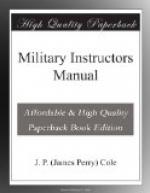8. ADJUTANT: “Inspect your guard, sir.”
9. OFFICER OF THE GUARD.—Faces about and commands: “Prepare for inspection.”
10. ADJUTANT (after the inspection is ended, and after posting himself 30 paces in front of and facing center of the guard—at the same time the new Officer of the Day takes position about 30 paces behind the Adjutant, facing the guard, and with the old officer of the day 1 pace in rear and 3 paces to the right): 1. Parade; 2. Rest; 3. Sound off. (The band, playing passes in front of the Officer of the Guard to the left of the line, returns to its post and ceases to play.) 1. Guard; 2. Attention; 3. Close ranks; 4. March. (As in the School of the Company.) 1. Present; 2. Arms. He then faces the new officer of the day, salutes, and reports: “Sir, the guard is formed.”
11. NEW OFFICER OF THE DAY (returning salute): “March the guard in review, sir.”
12. ADJUTANT.—He carries saber, faces about, brings the guard to the order and commands: “1. At trail, platoons right; 2. March; 3. Guard; 4. Halt.” The band takes post 12 paces in front of the first platoon, the Adjutant 6 paces from the flank and abreast of the Commander of the Guard, and the Sergeant Major 6 paces from the flank of the second platoon. Adjutant commands: “1. Pass in review; 2. Forward; 3. March.”
13. COMMANDER OF THE GUARD (as the guard reaches a position 6 paces from the Officer of the Day): 1. Eyes; 2. Right; (at 6 paces beyond the Officer of the Day) 3. Front.
At 12 paces beyond the Officer of the Day the Adjutant and the Sergeant-Major halt, salute and retire.
14. COMMANDER OF THE GUARD (as the Adjutant and the Sergeant Major retire): 1. Platoons, right by squads; 2. March. The guard is then marched to its post; the old guard is then relieved and sentinels posted according to the principles laid down in the Manual of Interior Guard Duty. (See diagrams at the end of this chapter.)
GUARD DUTY IN THE TRENCHES.—It differs from guard duty as we are accustomed to it. The challenge is not “Who is there?” but rather a sudden and imperative “Hands up.” The party challenged throws up his hands and gives the countersign in a low voice. Sentinels are posted in the front line and in the line of dugouts, one at each entrance to a dugout to give immediate warning. Watchers are posted at places having a good range of view; at night they keep watch over the parapets rather than through the loopholes since the latter afford only a narrow range of view. Auto riflemen (6 or 7 to a post) are used as watchers, one being on duty at a time. They should have a favorable background to provide concealment.
[Illustration: Plate 14]
[Illustration: Plate 14A.]
CHAPTER 13.
Company Administration.




